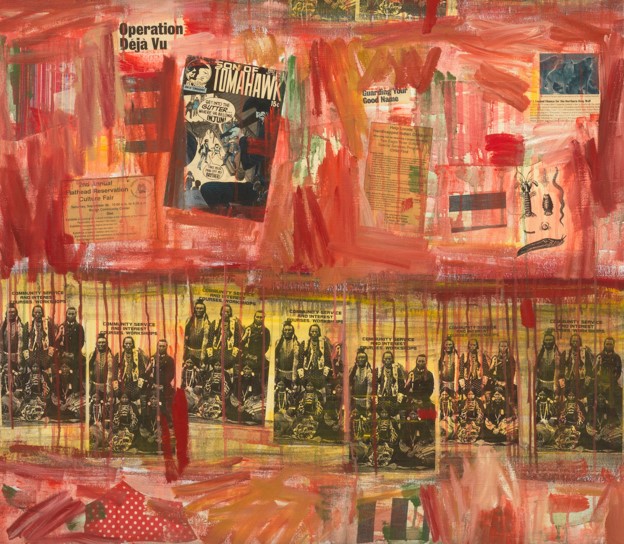Kendra Greendeer
Rematriating Indigeneity in Contemporary Native American Arts
Sitting in a gallery at the National Gallery of Art is a totemic triptych, with each segment placed vertically, that creates a monumental scale. Target, a work by Jaune Quick-to-See Smith (b. 1940), was created in 1992. The painting includes horizontal bands of alternating collaged images, expressive red paint layered with newspaper clippings, comic book covers, striped and polka-dot fabric, taxonomy drawings, and even local sports memorabilia of the infamously named Washington, DC, football team. The image shown consistently and duplicated within these alternating bands is a historical photo of three standing Native men and three Native women seated in front of them—all dressed in traditional regalia. The black-and-white reproductions, with accents of yellow paint on top, suggest the ability to reproduce or copy Indigenous culture.

Jaune Quick-to-See Smith, Target, 1992, mixed media on canvas, Purchased with funds from Emily and Mitchell Rales, 2020.6.1
Target is an abstract representation of an Indigenous person: the head is depicted as a dartboard with the upper half bordered in alternating colored darts; the plastic darts’ plumaged ends suggest a feathered headdress. The work includes stereotypical images, but along with this narrative of racial clichés is one of resistance and survivance. Target draws museum visitors in with familiar imagery and then delivers messages to “destroy the myth” and “[defy] the stereotype,” while also recognizing the settler-colonial targeting of Indigenous people and the commodification of Indigenous identity, further emphasized with clippings reading “Operation Déjà vu” and “the heist.”
These abstracted symbols of Indigeneity reintroduce Indigenous presence into the gallery: both the inclusion of an Indigenous artist (Smith) and the Indigenous reoccupation within a museum. While the National Gallery does not hold ethnographic or archaeological collections from North America, the institution recalls a history of collecting used to indicate imperial power. Thus, in the museum gallery, Target symbolizes Indigenous resistance introduced and welcomed through its abstracted presence.

Jaune Quick-to-See Smith, Target (detail), 1992, mixed media on canvas, National Gallery of Art, Washington, Purchased with funds from Emily and Mitchell Rales, 2020.6.1
Central to my discussion on Indigenous feminist art practices is “rematriation,” an Indigenous, women-led initiative to re-center Indigenous women, Indigenous feminist practices, and precolonial land ethics. Rematriation, as I discuss it, is action as an aesthetic praxis that addresses the museum and land while foregrounding Indigenous femininity. Rematriation and returning more than the “object”—for example, through the Native American Graves Protection and Repatriation Act of 1990—allows Indigenous people an opportunity to reinvigorate pre-settler values within Indigenous land.
My dissertation project examines the work of three contemporary Indigenous women artists: Smith, Nanibah Chacon (b. 1980), and Meagan Musseau (b. 1990). Their work represents an engagement with Indigenous placemaking practices that counters the settler-colonial agenda of commodifying lands and claiming Indigenous cultural object ownership. Due to these prevailing settler societal norms, the Indigenous women-led initiative of returning to a pre-settler state of gender equity as a relationship to the land is being reexamined, or remapped. At the same time, this initiative shows why a lens of Indigenous femininity is necessary as we look to all of our relationships to place.
Rematriation and its important expansion into visual studies are necessary efforts to restructure individuals’ relationships to life, balance, and respect toward the life-givers and those that allow for our “livingness.” It represents a return to a deeper sacred connection with what surrounds us and our position within place. It’s about getting something back—not just a tangible recovery but a restoration of the cultural elements that had been suppressed in order to promote a settler-colonial, patriarchal mindset.
While in residence at the Center, I had the privilege to visit works and experience spaces that Smith, Chacon, and Musseau explore. These ranged from a gallery in Calgary and a mural in Lansing, to collections along the East Coast, with extra time spent in the National Gallery’s room focused on pop art. Within each of the spaces, I recognize the Indigenous people that had or continue to occupy the lands surrounding these points, marking Indigenous presence associated with a place. Rematriation and the power of Indigenous femininity visually represented in the museum, as well as in urban and rural spaces, is an Indigenous-originated decolonization effort that affects and decenters settler narratives associated with Indigenous land.
University of Wisconsin–Madison
Paul Mellon Guest Predoctoral Fellow, 2022–2023
After defending her dissertation in June 2023, Kendra Greendeer will begin the fall semester as an assistant professor of art history at Oklahoma State University in Stillwater.
